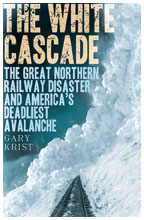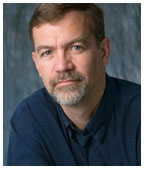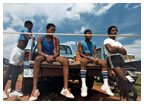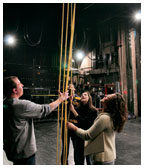April 4, 2007: Books and Arts
Reading Room
The forgotten slide
Gary Krist ’79 tells a lost tale of a train tragedy
World premiere of seminal Russian
work
Faculty and students launch the play Boris Godunov
For a complete list of books received, click here.
Gary Krist ’79 re-creates the harrowing lives of passengers and crew members trapped on board two 1910 trains. (Bob Krist) |
Reading
Room
The
forgotten slide
Gary Krist ’79 tells a lost tale of a train tragedy
By Justin Nyberg ’01
Gary Krist ’79 owes at least some credit for his latest book to Google. While looking into a book idea on the Internet, Krist punched in a few key words that brought up an unexpected subject — a dramatic avalanche that struck two snowbound trains high in the Cascade Mountains in 1910, killing almost 100 people. It remains the deadliest snowslide in American history but one that, despite a blitz of newspaper coverage at the time, had faded into obscurity. “I could not believe that this story was not better known when I stumbled across it,” Krist recalls.
 Four
years later, Krist’s discovery became The White Cascade: The
Great Northern Railway Disaster and America’s Deadliest Avalanche,
an account of the tragedy and its aftermath, published by Henry Holt in
February.
Four
years later, Krist’s discovery became The White Cascade: The
Great Northern Railway Disaster and America’s Deadliest Avalanche,
an account of the tragedy and its aftermath, published by Henry Holt in
February.
In the capitalistic rush to build a direct rail line between Spokane and Seattle, linking Minneapolis/St. Paul to the booming Northwest port, the Great Northern Railway had chosen to build a leg through the Cascades at an inhospitably steep place called Stevens Pass. During an unexpectedly long and brutal storm, avalanches covered the tracks at the pass, trapping Seattle-bound mail train No. 27 and passenger train No. 25 in place with about 55 passengers onboard. Other slides soon covered the tracks behind, blocking the trains’ escape. Over the next week, engineers and snowplow crews carried out a desperate but futile attempt to free the trains, as the passengers worried constantly about the stability of the steep slope above them.
“These people were staring their deaths in the face for a full week while the railroad was trying to free them,” says Krist. “By the end, everyone knew something was going to happen.” Readers know that, too. But Krist injects suspense into his retelling by painstakingly re-creating passengers’ daily lives in the trapped train cars, based on their letters, journals, and testimonies. As almost a week passes, the cast of ordinary families, business travelers, and train workers wrestle with their helplessness — some boldly attempting to hike down from the mountains on their own, others playing games to relieve the apprehension as food and coal supplies dwindle. In the end, 96 people perished — two-thirds of them train crew and track shovelers — while dozens survived.
Since little had been written about the disaster, Krist, a comparative
literature major at Princeton with no formal training in history, had
to compile many of the historical documents for the first time. It was
a new process for the Bethesda, Md.-based writer, who, as the author of
three novels, was used to mining only his imagination for his material.
Says Krist, “It was good to put my storytelling ability into a story
that really existed.” The experience has been rewarding enough,
Krist says, that he’s sticking with nonfiction. He already has begun
working on another historical book — the topic of which he is sharing
only with Google. ![]()
Justin Nyberg ’01 is an editor for Outside magazine in Santa Fe, N.M.
For a complete list of books received, click here.
 Good Bread
is Back: A Contemporary History of French Bread, the Way It Is Made, and
the People Who Make It — Steven Laurence Kaplan ’63
(Duke). French bread suffered a decline in quality in the 20th century
due to the replacement of centuries-old bread-making techniques with conveyor
belts that turned out flavorless fluff. The author tells the story of
the revival of French bread in the mid-1990s as bakers reclaimed their
reputations as artisans. Kaplan is a professor of European history at
Cornell.
Good Bread
is Back: A Contemporary History of French Bread, the Way It Is Made, and
the People Who Make It — Steven Laurence Kaplan ’63
(Duke). French bread suffered a decline in quality in the 20th century
due to the replacement of centuries-old bread-making techniques with conveyor
belts that turned out flavorless fluff. The author tells the story of
the revival of French bread in the mid-1990s as bakers reclaimed their
reputations as artisans. Kaplan is a professor of European history at
Cornell.
 From New
Recruit to High Flyer: No-Nonsense Advice On How To Fast Track Your Career
— Hugh Karseras ’95 (Kogan Page). This guidebook
offers advice on how to work one’s way up the corporate ladder by
developing the right attitude for success, acquiring analytical and people
skills, and becoming politically savvy. The author, who worked for McKinsey
& Co. in London before becoming director of an investment bank, draws
on his own experiences and those of top executives in the business world.
From New
Recruit to High Flyer: No-Nonsense Advice On How To Fast Track Your Career
— Hugh Karseras ’95 (Kogan Page). This guidebook
offers advice on how to work one’s way up the corporate ladder by
developing the right attitude for success, acquiring analytical and people
skills, and becoming politically savvy. The author, who worked for McKinsey
& Co. in London before becoming director of an investment bank, draws
on his own experiences and those of top executives in the business world.
 Tom Thomson in
Purgatory — Troy Jollimore *99 (MARGIE). The title poem
of this collection is a sequence of 42 sonnets that explore love, work,
time, pain, and sorrow, as experienced by the everyman Tom Thomson. The
book won the 2006 National Book Critics Circle Award for poetry and the
Robert E. Lee and Ruth I. Wilson Poetry Award. Jollimore teaches philosophy
at California State University, Chico.
Tom Thomson in
Purgatory — Troy Jollimore *99 (MARGIE). The title poem
of this collection is a sequence of 42 sonnets that explore love, work,
time, pain, and sorrow, as experienced by the everyman Tom Thomson. The
book won the 2006 National Book Critics Circle Award for poetry and the
Robert E. Lee and Ruth I. Wilson Poetry Award. Jollimore teaches philosophy
at California State University, Chico. ![]()
By K.F.G.
For a complete list of books received, click here.
The 1987 photograph Roped Off, right, by Dan Williams, is among works
by contemporary African-American artists featured in the exhibition “History,
Identity, or None of the Above: Regarding African-American Art,”
on view at the Princeton University Art Museum through May 13. Williams’
work, in which the young men’s movement appears to be curtailed
by a twisted wire rope, is a commentary on contemporary politics and race
relations. “Part of the appeal of the photograph for me was the
fact that it doesn’t tell us the full story,” says Rachael
Z. DeLue, an assistant professor in the art and archaeology department
who organized the exhibit to accompany her course “History of African-American
Art.” The other works in the exhibit, which presents a range of
periods, geographic regions, and subject matter, include prints, collages,
and drawings.![]()
(Photo courtesy PUAM)
McCarter Theatre technical director Chris Nelson, left, tests the tubing, part of the set design for Boris Godunov, on stage with Becca Foresman ’10, center, and Rory Weisbord ’07. (Denise Applewhite/Office of Communications) |
World
premiere of seminal Russian work
Faculty and students launch the play Boris Godunov
By Maria LoBiondo
Political intrigue. Romance. Cultural confrontation.
Even though Russian literary giant Aleksandr Pushkin wrote his historical drama Boris Godunov almost 200 years ago, its themes resonate today, says Professor Caryl Emerson, who has studied and written extensively about the play to be performed at the Berlind Theatre April 12–14. The Berlind presentation will premiere a new English translation of the work and a production inspired by an ambitious interpretation that never reached the Russian stage.
Best known as an opera, Boris Godunov follows the Russian czar’s brief reign from 1598 to 1605. Rising to power under Ivan the Terrible and his successor, Godunov falters when Russia suffers from famine and economic collapse. His ultimate downfall comes when a pretender to the throne invades Russia claiming to be Ivan’s youngest son, murdered by Godunov but now resurrected.
Tim Vasen, lecturer in the Program in Theater and Dance, is directing an ensemble of 13 undergraduates who take on the 70 speaking parts. “I think the story will be easy to follow, and will feel quite dynamic and in some ways really modern,” he says. “It has at its center someone who invents his own identity, creates his own media buzz, and becomes the perfect receptacle for conflicting desires floating around society.”
The impetus for the project came when music professor Simon Morrison *97, conducting research for a book on Sergei Prokofiev at the Russian State Archive of Literature and Art in Moscow, unearthed long-forgotten manuscripts of the composer’s incidental music for a 1936 production of Boris Godunov. “It’s accessible music,” Morrison says, “very kinetic. This score is supposed to shake your body.” Innovative Russian director Vsevolod Meyerhold had commissioned the music and begun blocking out scenes for the play, but aborted the work in the political heat of the Stalinist times.
With Emerson, chairwoman of the Department of Slavic Languages and Literatures, Morrison conceived of a first: an integration of Meyerhold’s vision with Prokofiev’s music and a new translation of Pushkin’s words by the noted translator Antony Wood.
Vasen is incorporating Meyerhold’s ideas on expressing the inner life of a character through physical gesture and movement. The set will help: Vasen describes it as “a giant jungle gym” with climbing ladders and cords, and a three-tier platform at the back of the stage reminiscent of the television show Hollywood Squares for orchestra members and actors to employ.
Undergraduates will be involved in Boris Godunov not only as actors, but also as dancers, singers, and musicians. Graduate students in the School of Architecture designed the set.
“The process is a performance,” says Morrison. “It’s
all about the potential and the challenges. The process is as much a drama
as what takes place on stage.” ![]()
Maria LoBiondo is a PAW contributor.



